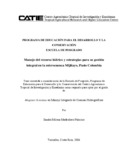| dc.contributor.advisor | Jiménez, F. | |
| dc.contributor.author | Madroñero Palacios, Sandra M. | |
| dc.contributor.other | CATIE - Centro Agronómico Tropical de Investigación y Enseñanza | |
| dc.date.accessioned | 2014-10-20T05:19:13Z | |
| dc.date.available | 2014-10-20T05:19:13Z | |
| dc.date.issued | 2006 | es_ES |
| dc.identifier | 367668 | es_ES |
| dc.identifier.uri | https://repositorio.catie.ac.cr/handle/11554/5307 | |
| dc.description | Tesis (Mag. Sc.) -- CATIE, 2006 | es_ES |
| dc.description.abstract | El estudio se desarrolló en la microcuenca Mijitayo en el Municipio de Pasto, en donde el principal objetivo fue analizar el manejo dado por los diferentes usuarios al recurso hídrico disponible en la microcuenca y establecer estrategias para la gestión integral del mismo. Finalmente, se realizaron análisis de aguas en las fuentes estudiadas, muestras que fueron tomadas en época de verano en la parte alta, media y baja del río y sus afluentes, siendo el Río Mijitayo la fuente con mayor contaminación. Teniendo en cuenta estos resultados se establecieron estrategias para el manejo integral del recurso hídrico tales como: La conformación de un comité encargado del manejo de la microcuenca Mijitayo, crear un código de uso de los recursos naturales que considere las situaciones específicas del área, generar mecanismos de participación comunitaria, coordinación interinstitucional y desarrollo de alianzas estratégicas y promover cambios de actitud en toda la población presente en el área de estudio.
This study was conducted in the Mijitayo micro-watershed in the Pasto municipality. The principle objective was to analyze the management used by the different users of the available hydric resource in the micro-watershed and to establish strategies for its integrated management. Finally, an analysis was conducted for water in the springs studied, samples were taken in the summer in the high, medium and low parts of river and its tributaries with the Mijitayo River being the source of greatest contamination. Taking into account these results, strategies were established for integrated management of the hydric resource. These included: the creation of a committee in charge of managing the Mijitayo micro-watershed, the creation of a natural resource use code that considers the specific situations of the area, the generation of community participation mechanisms, inter-institutional coordination and development of strategic alliances and the promotion of changes in attitude in the entire population in the study area. | es_ES |
| dc.language.iso | es | es_ES |
| dc.publisher | CATIE, Turrialba (Costa Rica) | es_ES |
| dc.relation.ispartof | Maestría en Manejo y Gestión en Cuencas Hidrográficas | |
| dc.rights | info:eu-repo/semantics/openAccess | es_ES |
| dc.subject | CUENCAS HIDROGRÁFICAS | |
| dc.subject | RECURSOS HÍDRICOS | |
| dc.subject | ORDENACIÓN DE CUENCAS | |
| dc.subject | ORDENACIÓN DE RECURSOS | |
| dc.subject | AGUAS RESIDUALES | |
| dc.subject | POLUCIÓN DEL AGUA | |
| dc.subject | GESTIÓN | |
| dc.subject | LEGISLACIÓN MEDIOAMBIENTAL | |
| dc.subject | USO DEL AGUA | |
| dc.subject | COLOMBIA | |
| dc.subject.other | Sede Central | |
| dc.title | Manejo del recurso hídrico y estrategias para su gestión integral en la microcuenca Mijitayo, Pasto, Colombia | es_ES |
| dc.title.alternative | Management of hydric resources and strategies for their integrated management in the Mijitayo micro-watershed in Pasto, Colombia | es_ES |
| dc.type | Tesis de maestría | es_ES |


